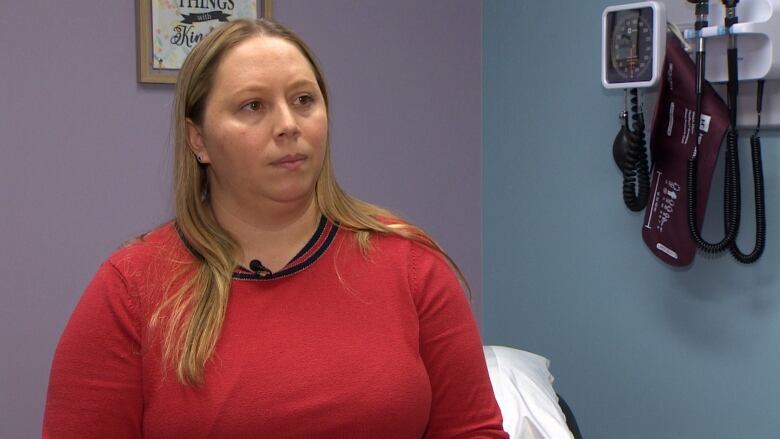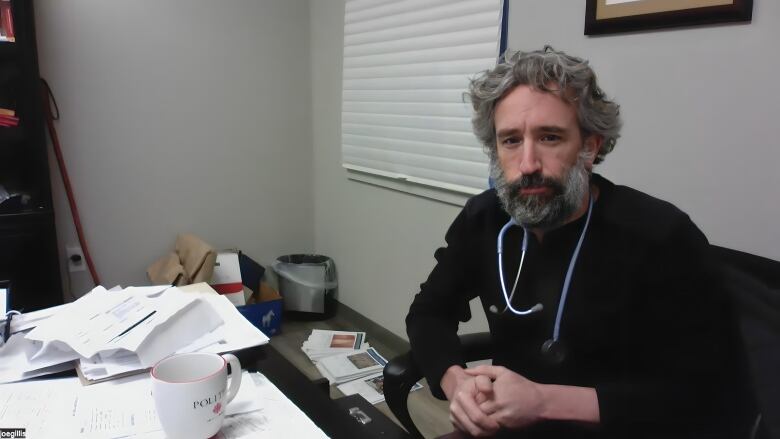Canadian doctors spend millions of hours on unnecessary paperwork each year: report
Report says Nova Scotia is leading the way in reducing administrative burden

Dr. Leisha Hawker reservesa full work day each week just to dopaperwork.She sees no patients and works through form after form, so she can get home in time to put herdaughter to bed.
She's not alone in this routine.
The Halifax family doctor, who is also the president of Doctors Nova Scotia, said it's estimated that most physicians in the province spend about 10 hours a week dealing with unnecessary paperwork.
This means someone else could do it, or it doesn't need to be done at all.She said this work accounts for about 500,000 hours of physician work per year in Nova Scotia, and often falls on nights and weekends.
"A lot of younger physicians that have a family will do two shifts," Hawker said."You'll go home and take your kid to judo or swimming or whatever it is, put them to bed and then log back in anddo more work and then go to bed late at night."
In 2019, the provincial governmentpartnered with Doctors Nova Scotia to research physician administrative burdenand how to reduce it. A new report released Monday builds on this research and draws conclusions that apply to the whole country.
The Canadian Federation of Independent Business's report, Patients Before Paperwork, shows Canadian doctors spend 18.5 million hours annually on unnecessary administrative work the equivalent of 55.6 million patient visits.
"Health ministries across Canada are facing many complex challenges," the report said."Achronic shortage of health professionals, an aging population and capacity constraints all have put pressure on the health-care system and the physicians who support it."
Target to reduce administrative burden
An Angus Reid pollfrom September 2022 foundhalf of Canadians are either unable to seetheir family doctorwithin a week,or they can'tfind a doctor at all.
Monday's CFIB report concludes that if governments across Canada set a target to reduce physician administrative burdenby 10 per cent, they could reduce fatigue and burnout, improve the quality of patient careand open the equivalent of 5.5 million patient visits a year.
"We know that all of the premiers are working with the federal government on hashing out a new deal on the health-care side, that is very important," said Ryan Mallough, CFIB's vice-president of legislative affairs.
"But we want to make sure that we're not forgetting about the other things that we can do in the system ... if it's eliminating aform that doesn't need to be filled out by a doctor or if it's reducing a 12-page form to a three-page form.That adds up and it is going to free up doctors' time to see their patients."

Nova Scotia leading the way
Nova Scotia has been working on reducing physician administrative burdensince 2019.
Mallough said this is trailblazing work, and he hopes other provinces will follow suit.
"We know that medical associations have been flagging this with their provincial governments, but as far as we know, no one has come out and done anything as robust as what Nova Scotia has done," he said.
The provincial Office ofRegulatory Affairs and Service Effectiveness took the lead on the project and outlined 15 actions that would reduceunnecessaryadministrative burdenby 10 per centby 2024.
Leanne Hachey, the executive director of the office, said 500 physicians were surveyed in Nova Scotia.
"We heardthat burden looks like many different things. It looks like paperwork that's too long, forms that are duplicative, different bodies asking for the same information, things that they have to do on paper as opposed to doing digitally. Processes that just don't make sense."
Hachey said her office has acted as a liaison between doctors and provincial departments to help them work together andmake changes.

Joe Gillis, a physician in Yarmouth, N.S., said his desk is often piled with forms, which he'll "pick at itduring the course of the day."
But he said if he doesn't keep on top of it, things likeinsurance and income assistance forms, medical reviews for drivers and disability tax creditscan "get out of control."
He said he's happy to see the government committing to reducing this type of extra work, but the province has a long way to go.
"Health care is difficult right now, both as a patient and provider," Gillis said. "And I think anything we can do to alleviate that difficulty isjust a step in the right direction for everybody."
He said he's already heard aboutsome notoriously long and cumbersome forms being shortened, but he hopes more technology will be used in doctor's offices to further reduce the work.
'Taking a fork and chipping away at an iceberg'
The provincial Office ofRegulatory Affairs and Service Effectiveness has less than a year to complete their goal of a 10 per cent reduction.
Hachey said the office's physician impact assessment tool shows they're halfway there, but shebelieves they'll meet the target, or even surpass it.
"Sometimes it does feel like you're taking a fork and chipping away at an iceberg because there is so much," Hachey said."What we have to do is start, show some success,make sure that physicians feel the impact and then start to do more."
She said the focus is saving minutes of work for each physician.
"But when you build that up to 2,500 physicians that may be doing it 50 times a year, those minutesstart to add up to big hours and to annual patient visits."
Hawker said the 10 per cent reduction target is the equivalent to about 150,000 patient visits per year. Currently, there are nearly 130,000 Nova Scotians on the primary-care wait list.
"That would be a visit for every single person that would beon the wait list," Hawker said."So even a 10 per centreduction in administrative burden could have significant impacts on patient care and the health-care system."
Hachey said her office has already heard from the British Columbia and Manitoba governments about reduction efforts, and hopes more will come forward.












_(720p).jpg)


 OFFICIAL HD MUSIC VIDEO.jpg)
.jpg)



























































































